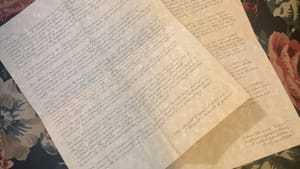Stay in the Loop
BSR publishes on a weekly schedule, with an email newsletter every Wednesday and Thursday morning. There’s no paywall, and subscribing is always free.
A letter from Miss Dickinson
EgoPo Classic Theater presents ‘Emily’ by Brenna Geffers and Natalia de la Torre

The first letter opens with an outpouring of affection, tinged with sorrow: “I long to see you, dear, and speak with you face to face, but so long as bodily interview is denied us, we must make letters answer.” It might surprise you to see those words attributed to the famously reclusive Emily Dickinson. But Emily, the theater-through-mail event crafted by Philadelphia artists Brenna Geffers and Natalia de la Torre, seeks to upend any preconceived notions about poetry’s most celebrated homebody.
Our constraints
Although addressed to an unknown “Dearest Friend,” the stated desire for intimate connection may also speak directly to the recipient, as we all find ourselves missing so many people amid this period of forced separation. EgoPo Classic Theater, under whose auspices Emily is being distributed, often themes its seasons—its current program, titled Isolations, requires little explanation. Yet the project reinforces that Dickinson herself was not defined by her constraints, and neither should we be.
From the time she returned home from Mount Holyoke College until her death, at age 55, Dickinson lived a solitary life at her family home in Amherst, Massachusetts. Correspondence was her connection to the world beyond her hearth, just as the voluminous poetry she amassed (but rarely published) served as the expression of her soul. The calcified image of Dickinson as an erratic, eccentric hermit stands in stark contrast to the passion of her poetry, and the discussion of her life and work often occurs in gendered, sexist terms.
Luckily, recent years have brought a renewed interest reconsidering this writer on her own terms. The Belle of Amherst, William Luce’s treacly one-woman bioplay, has largely died with its famous interpreter, Julie Harris. Terence Davies’s brilliant and underseen film A Quiet Passion (2017) portrayed Dickinson as strong-willed and self-possessed, and the ongoing Apple TV series Dickinson treats its subject with a welcome sense of irreverence. Geffers’s and de la Torre’s Emily adds something of value to this much-needed reappraisal.
Drawing us in
The work is being distributed episodically, so it’s difficult to consider its entire impact based on a piecemeal approach. (I received the first two parcels in my mailbox recently, with several more expected in the coming weeks.) What feels evident from the start is a sense of drawing in the audience, just as an engrossing theatrical production would. Geffers, a director and deviser, and de la Torre, a costume designer, have an eye for aesthetics: The papers chosen for these letters seem distressed and aged, even though they’ve been freshly printed. The font chosen (even if it is computer generated) has the same peculiar slant of Dickinson’s own hand.

Appearances only take you so far, though, and that is where the gripping content kicks in. The first letter, which we come to realize is meant for a Mount Holyoke chum, brims with life and potential. It recounts a trip to Boston’s Chinese museum that plants the seed for an excursion to the genuine article. Emily implores herself and her Dearest Friend to “ask the advice of no one and heed only our beautiful tempers.” This content banishes the figure of a shy, retiring girl who retreated into her bedroom in terror of the world. It overflows with vigorous life.
The new Dearest Friend
The second letter reads as more circumspect, but not at all ascetic; Emily reiterates that “the world holds a predominant place in my affections.” She rejects religious devotion because it is overly tied to renunciation. The snatches of poetry selected by Geffers and de la Torre further reinforce Dickinson’s energy and stamina, although a quotation in the first letter omits a crucial word—never—from the first line of Poem 144.
The first parcel also includes a sheet of paper and a return envelope, with the recipient implored to become the Dearest Friend herself. What anyone chooses to write is their own concern. As a dyed-in-the-wool theater critic, few things make my blood run cold quite like audience participation, but the moment demands connection. In the meantime, I’ll use the platform I’m more comfortable with to evangelize for Emily, a unique and wonderful experience we should all embrace.
Image description: A pair of long letters, written in close lines with flourishing, slanted text, lie on a flowered tablecloth.
Image description: A black-and-white photo of Emily Dickinson taken in the 1840s. Her dark hair is parted in the middle and she wears a black dress with a ribbon around her neck. She sits in a chair and looks directly at the camera. Her elbow rests on a table beside her. The table has a book on it.
What, When, Where
Emily. By Brenna Geffers and Natalia de la Torre. EgoPo Classic Theater. Ongoing, distributed by mail. First mailings sold out; second mailings ($50 per household) begin October 26, 2020. Egopo.org.
Sign up for our newsletter
All of the week's new articles, all in one place. Sign up for the free weekly BSR newsletters, and don't miss a conversation.

 Cameron Kelsall
Cameron Kelsall